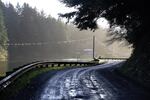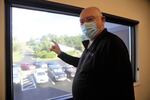
Lower Big Creek Reservoir is one of two leaking reservoirs that supply water to Newport. A large earthquake would wipe them out. Even a smaller one would likely rupture the concrete supply lines. Now the City of Newport is considering building one big safer dam on the same sight so they don't have to keep pumping water out of the Siletz River.
Kristian Foden-Vencil / OPB
The most basic need in any community is water. It’s simple: No water, no town.
So it was a frightening surprise recently, when residents of Newport learned that their two reservoirs were leaking and in danger of failing.
“If we had a subduction earthquake, a nine, it would certainly go,” Dr. Ralph Breitenstein said recently of the city’s older reservoir.
That facility was built in 1951, using little more than diggers to push dirt across a small valley and dam Big Creek. If the dam was ever breached, experts say more than 280 average-sized swimming pools worth of water per second could pour out, inundating the community below.
The second earthen dam was built in 1968 and isn’t much safer.
“If we had a three or a four, a crustal earthquake,” Breitenstein said, “we would probably lose our water also because the water lines from the dam to the hospital are old and fragile, made of asbestos cement.”

Dr. Ralph Breitenstein, points to the location of the big new water tower that's going to be built above Newport's new hospital.
Kristian Foden-Vencil / OPB
The water supply is of particular concern to Breitenstein as he’s chair of the local Pacific Communities Health District. The health district was in the middle of building a new hospital in Newport when Breitenstein learned of the water problem. Now the hospital faces a multi-million dollar bill to construct a big new water tank.
“What we need to do is have a tank that’ll run the hospital for a month,” Breitenstein said.
As a critical-access hospital, Samaritan Pacific Communities Hospital needs a month’s worth of clean water after an earthquake for everything from cleaning wounds to sterilizing equipment.
But it’s not just hospitals that need water, and it’s not just an earthquake threatening Newport’s supply. Breitenstein said everything from population growth to erratic weather is putting pressure on the water system in this coastal community.
“It looks like we’re getting more rain, with those atmospheric rivers that have been seen over the last few weeks,” he said. “And we’re having drier periods in the summer.”
“Our rain is becoming more cyclical. I think that’s probably climate change.”
Drought on the coast
Oregonians have talked a lot about drought in recent years, as scientists report record dry conditions, and farmers, firefighters and others live with the immediate consequences.
When thinking about drought, Newport and the Oregon Coast don’t usually come to mind. But for the last few summers, people in Newport and other coastal cities have been asked not to wash cars and irrigate lawns because of water shortages. And civic leaders in places such as Newport are thinking through potential long-term solutions.
Most of Newport’s water comes from those two reservoirs formed by upper and lower Big Creek dams, just north of town.
They fill up in the winter and are drained in the summer. When the water gets too low, which is happening increasingly often, Newport pumps water out of the Siletz River.
The system has worked for decades. But when the city started building a new water treatment plant a few years ago, engineers found the soil around the dams was susceptible to liquefaction. It was also salty and organic – meaning it could rot and was unstable.

Newport city manager Spencer Nebel points to the dam that is leaking and needs to be replaced. The hope is a new facility will mean Newport won't have to pump water out of the Siletz River to meet supply in the summer.
Kristian Foden-Vencil / OPB
On a recent visit to the upper dam, Newport city manager Spencer Nebel pointed to a large pipe sticking out of the facility. He explained how crews just fixed one leak there and said it will need more work next year.
“(I) hate to make this kind of investment here for a facility that we’re planning to replace,” he said. “But it is a legitimate safety concern. And the security of the system is critical for the community and for the folks that live downstream.”
Now the city plans to build another, concrete dam halfway between the two older ones.
“So if we can build a higher dam and build a bigger basin, that’s going to reduce our reliance on the Siletz River, which is a really important environmental consideration here,” Nebel said. “And we’ve been working closely with the Siletz Tribe.”
Historically, Pacific Northwest tribes have often not been supportive of government-built dams, because of their propensity to block fish runs. But Robert Kentta with the Confederated Tribes of Siletz Indians said pumping water out of the Siletz River every summer is really bad for salmon, lampreys, crayfish and river mussels.
“We had the lowest flows that I can remember and I’ve lived here for nearly 60 years,” Kentta said. “It was scary low and scary warm. It was like bathwater, and we’re just not used to those kinds of temperatures in our river.”
Kentta said a new, larger dam and reservoir on Big Creek would mean more water could stay in the Siletz River and more fish would likely survive.
He’s also not too concerned about fish in Big Creek because, he said, “Big Creek” is a misnomer. It’s not that big and a dam has blocked fish passage there for 70 years.
“The new concrete dam being built would have no initial impact,” Kentta said. “I don’t think it’s all been designed, but there’s potential for there possibly to be a fish ladder put into the new dam.”
Experts say the entire state of Oregon is becoming less resilient to drought, as fewer cold winters create the large snow packs needed to hydrate environments through long, hot summers.
Siletz members around Newport used to spend the entire month of May collecting young hazel sticks to make baskets. Now spring comes so early that the sticks are too mature to harvest by the end of the month.

Local scaffolder Lewis Napoleon fishes for trout in Upper Big Creek Reservoir. He understands a new dam would likely mean higher local taxes. "I think is a good idea in the long run. It could also potentially open up jobs.”
Kristian Foden-Vencil / OPB
Spurred on by such stories, as well as catastrophic wildfires and new plant growth, fried to a crisp by early heatwaves, towns along the central coast have formed the Mid-coast Water Conservation Consortium.
“We’ve always really had a message of conservation,” said Stephanie Reid, with Lincoln City’s public works department. “But we need to make it louder,”
Meanwhile, Newport’s new $80 million dollar dam is still years away. And that kind of money means voters will likely have to sign-off on a bond measure.
Local fisherman Lewis Napoleon, who spin fishes for trout at the upper Big Creek reservoir, said he would be OK with higher taxes.
“If they’re going to have to build it to secure water, you know, an emergency situation… I think it is a good idea in the long run,” he said.
“It could also potentially open up jobs.”
